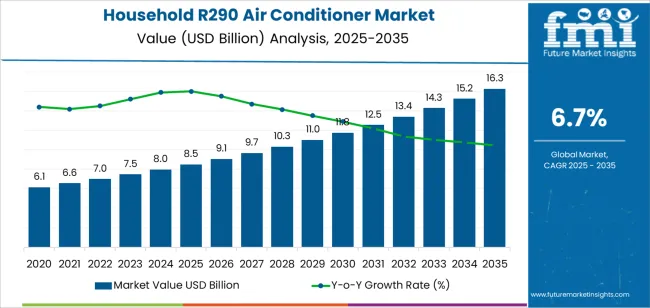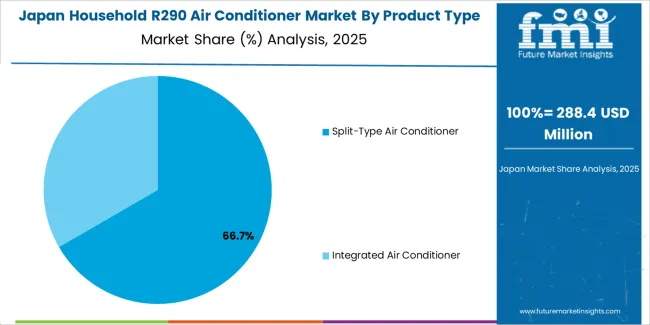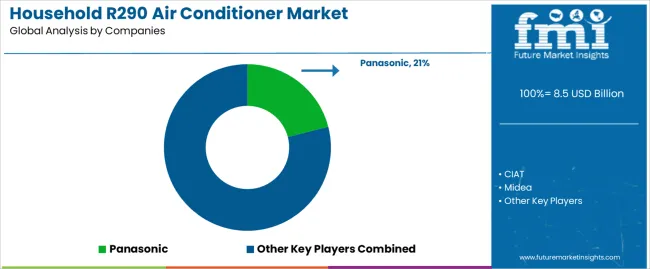The household R290 air conditioner market is valued at USD 8.5 billion in 2025 and is expected to reach USD 16.3 billion by 2035, expanding at a CAGR of 6.7%. Market growth is driven by increasing residential demand for energy-efficient cooling systems, rising environmental regulations limiting high-GWP refrigerants, and the shift toward ecofriendly air-conditioning solutions. R290 (propane) refrigerant has gained industry acceptance for its low global warming potential, high thermodynamic efficiency, and compatibility with compact household systems, contributing to its growing integration in next-generation HVAC appliances.
Split-type air conditioners account for the largest market share due to their operational efficiency, widespread availability, and suitability for R290 applications in small and medium residential spaces. Advancements in compressor design, safety mechanisms, and refrigerant charge management are enabling safe use of hydrocarbon refrigerants while meeting international safety standards. The adoption of inverter-driven compressors and smart home integration continues to enhance comfort, performance, and energy optimization across residential installations.

Asia Pacific leads market expansion, supported by strong housing growth and rapid cooling equipment penetration in China, India, and Southeast Asia. Europe and North America maintain steady adoption through environmental policy alignment and consumer preference for ecofriendly products. Leading manufacturers include Panasonic, CIAT, Midea, Gree, Haier, TCL, Aux, Hisense, and Changhong, focusing refrigerant innovation, efficiency upgrades, and compliance with green building standards.
Growth momentum analysis shows a strong upward trajectory during the first half of the forecast period, driven by regulatory mandates promoting low-GWP refrigerants and growing consumer awareness of ecofriendly cooling solutions. Between 2025 and 2029, momentum will be reinforced by rapid product adoption in Asia-Pacific, where large-scale residential construction and rising middle-class income levels will accelerate market penetration. Manufacturers’ transition toward R290-compatible designs will further sustain early acceleration.
From 2030 to 2035, growth momentum will remain steady but begin to moderate as key markets approach regulatory compliance and penetration levels stabilize. Replacement demand, driven by energy efficiency upgrades and lifecycle transitions from R22 and R410A systems, will maintain consistent expansion. Product advancements in safety design, compressor technology, and compact unit integration will maintain technological competitiveness. The overall momentum pattern indicates durable long-term growth supported by environmental policies, efficiency improvements, and consumer preference for climate-friendly air conditioning solutions in the residential sector.
| Metric | Value |
|---|---|
| Market Value (2025) | USD 8.5 billion |
| Market Forecast Value (2035) | USD 16.3 billion |
| Forecast CAGR (2025-2035) | 6.7% |
The household R290 air conditioner market is growing as consumers and manufacturers shift toward low-global-warming-potential refrigerants in residential cooling systems. R290, also known as propane, offers significantly lower global warming potential and better thermodynamic efficiency compared to traditional HFC refrigerants, making it attractive for domestic air conditioners designed for ecofriendly and energy savings. Adoption is driven by tightening regulations on refrigerant emissions, energy-efficiency standards, and increased consumer awareness of environmentally friendly appliances. Growth is also supported by declining manufacturing costs and wider availability of production lines capable of handling flammable refrigerants under safety frameworks. Residential air conditioner demand in emerging regions with growing middle classes and expanding air-conditioning penetration further accelerates uptake of R290-based units.
The market faces challenges because R290 is a flammable refrigerant, requiring smaller charge sizes, stricter safety certification, and revised installation codes for household equipment. Technician training and service infrastructure must adapt, which increases operational complexity. Regional differences in safety regulations, code acceptance and component supply chains may delay full adoption.
The household R290 air conditioner market is segmented by product type and application. By product type, the market is divided into split-type air conditioner and integrated air conditioner. Based on application, it is categorized into online sales and offline sales channels. Regionally, the market is divided into Asia Pacific, Europe, North America, and other key regions.

The split-type air conditioner segment holds the leading position in the household R290 air conditioner market, representing an estimated 69.0% of total market share in 2025. Split-type systems are preferred in residential settings due to their high energy efficiency, quiet operation, and flexible installation across varying room sizes. These systems employ R290 (propane) as a natural refrigerant, offering low global warming potential (GWP) and excellent thermodynamic performance.
The dominance of this segment is supported by growing consumer awareness of environmentally friendly cooling solutions and the phasing out of high-GWP refrigerants under international environmental regulations. Split systems also benefit from improved inverter compressor technologies that optimize power consumption while maintaining stable cooling performance. The integrated air conditioner segment, estimated at 31.0%, remains relevant in multi-room homes and compact apartments where all-in-one units are valued for ease of installation and lower initial costs.
Key factors supporting the split-type air conditioner segment include:

The offline sales segment accounts for approximately 58.0% of the household R290 air conditioner market in 2025. Traditional retail distribution, including appliance stores, dealer networks, and brand showrooms, continues to dominate due to consumers’ preference for in-person product evaluation, technical consultation, and installation support. Offline channels also facilitate better after-sales service and warranty management, making them the preferred purchasing mode for high-value home appliances such as air conditioners.
The online sales segment, estimated at 42.0%, is expanding rapidly, supported by the growth of e-commerce platforms offering diverse product options, competitive pricing, and direct manufacturer sales. Online retail adoption is particularly high in urban areas, where digital infrastructure and doorstep installation services enhance convenience for consumers purchasing R290 air conditioning systems.
Primary dynamics driving demand from the offline sales segment include:
Global shift to low-GWP refrigerants, residential cooling demand increase, and energy-efficiency mandates boost adoption.
The household R290 air conditioner market is propelled by increasing regulatory pressure to phase down high-GWP refrigerants and transition to natural alternatives such as R-290 (propane). The residential segment accounts for a dominant share of R290 A/C deployment, reflecting household demand as the primary end-use application. In warmer climates and expanding urban centres, rising incomes and space-cooling requirements drive greater household air-conditioner uptake. R290’s thermodynamic performance and compatibility with inverter technology enhance energy-efficiency credentials, which aligns with consumer and policy focus on sustainability in home appliances.
Safety concerns around flammability, higher unit cost and retrofit compatibility issues limit uptake.
Although R290 offers environmental benefits, its flammability represents a major safety challenge in household systems, imposing stricter charge limits, additional monitoring devices and certification requirements that raise manufacturing and installation costs. Premium pricing of R290-based models compared with conventional units may deter cost-sensitive consumers in emerging markets. Existing household A/C units may not support direct refrigerant retrofit to R290 without redesigning components, which slows replacement cycles and restricts conversion.
Integration of smart controls, regional growth in high-demand markets and modular product formats define future direction.
Household R290 air conditioners are increasingly offered with IoT-connectivity, smart thermostats and remote diagnostics to maximise efficiency and user convenience. Growth is strongest in Asia-Pacific regions, where hot climates and large residential populations coincide with supportive policy frameworks for low-GWP refrigerants. Modular system formats such as split-type and portable units pre-charged with R290 are emerging as flexible options for households in varied installation contexts. These trends are consolidating R290 technology as a mainstream ecofriendly choice for home cooling.
The global household R290 air conditioner market is expanding rapidly through 2035, driven by environmental regulations restricting high-GWP refrigerants, consumer demand for energy-efficient appliances, and progress in eco-friendly cooling technology. China leads with a 9.0% CAGR, followed by India at 8.4%, reflecting large-scale adoption of natural refrigerants in the residential HVAC sector. Germany grows at 7.7%, supported by ecofriendly housing initiatives and heat pump integration. Brazil records 7.0%, driven by green building projects and appliance modernization. The United States grows at 6.4%, focusing energy efficiency standards and retrofitting programs, while the United Kingdom (5.7%) and Japan (5.0%) maintain growth through R&D-driven innovation and compact system optimization.

| Country | CAGR (%) |
|---|---|
| China | 9.0 |
| India | 8.4 |
| Germany | 7.7 |
| Brazil | 7.0 |
| USA | 6.4 |
| UK | 5.7 |
| Japan | 5.0 |
China’s household R290 air conditioner market grows at 9.0% CAGR, supported by mass production capability, government policy mandates, and export competitiveness. The China Green Cooling Initiative accelerates the replacement of HFC-based systems with R290 (propane), which offers low GWP and high thermodynamic efficiency. Major HVAC manufacturers are expanding product lines using variable-speed compressors and optimized heat exchangers for improved performance. Local authorities support subsidy programs promoting green household appliances. Production hubs in Guangdong, Zhejiang, and Jiangsu supply domestic and regional demand for environmentally compliant residential systems.
Key Market Factors:
India’s market grows at 8.4% CAGR, driven by ecofriendly cooling strategies, rising household income, and climate policy implementation. The India Cooling Action Plan (ICAP) promotes R290 adoption as a low-emission alternative to HFC-based refrigerants. Domestic manufacturers are scaling production of split air conditioners optimized for high ambient conditions. R&D efforts focus on flammability mitigation, refrigerant containment, and energy efficiency. Urban housing development and expanded electricity access are increasing household AC penetration. The Make in India initiative supports local component production, enhancing supply chain resilience.
Market Development Factors:
Germany’s market grows at 7.7% CAGR, supported by energy efficiency standards, green building certification programs, and low-carbon refrigerant initiatives. Compliance with the EU F-Gas Regulation drives adoption of R290 systems across new housing developments. HVAC companies are developing compact, hermetically sealed systems designed for safety and efficiency. Integration with heat pump technology enhances year-round temperature control. Consumer awareness of lifecycle emissions and energy costs is promoting a shift toward natural refrigerant-based appliances. Continuous R&D investment strengthens Germany’s position in the European ecofriendly cooling segment.
Key Market Characteristics:
Brazil’s market grows at 7.0% CAGR, supported by modernization of the appliance sector and environmental policy alignment. The National Climate Policy encourages low-GWP refrigerant adoption in residential systems. Domestic assemblers are licensing R290 compressor and system designs from Asian manufacturers. Rising electricity costs and frequent heat events increase demand for efficient cooling appliances. Energy labeling and consumer incentive programs under the PROCEL initiative strengthen product competitiveness. Local production expansion ensures broader regional accessibility and reduced import dependency.
Market Development Factors:

The United States grows at 6.4% CAGR, driven by appliance energy efficiency mandates, regulatory transition, and system retrofitting. The American Innovation and Manufacturing (AIM) Act supports HFC phasedown and natural refrigerant adoption. Manufacturers are developing propane-based systems for single-room and small split applications with enhanced safety features. Integration of inverter technology and smart thermostat control reduces energy use. Federal and state incentive programs encourage consumer adoption of low-emission systems. Retrofit projects targeting residential HVAC upgrades accelerate R290 adoption in select segments.
Key Market Factors:
The United Kingdom’s market grows at 5.7% CAGR, supported by policy alignment, ecofriendly housing programs, and advanced HVAC technology. The UK F-Gas Regulation and Net Zero Strategy promote use of low-GWP refrigerants such as R290 in residential systems. Domestic and European manufacturers supply compact, hermetically sealed units for urban dwellings. Building performance standards emphasize refrigerant lifecycle impact, driving preference for natural alternatives. Training programs for installation safety certification support gradual adoption. Replacement of legacy systems with energy-efficient R290 units continues across new housing projects.
Market Development Factors:

Japan’s market grows at 5.0% CAGR, reflecting strong emphasis on innovation, miniaturization, and energy performance. Domestic HVAC producers are engineering R290 systems optimized for small living spaces with advanced heat exchangers and compressor control. Government programs under the Green Innovation Fund support low-carbon technology R&D. Manufacturers focus on reducing refrigerant charge and enhancing cooling stability under varying temperatures. Integration of AI-assisted energy management enables precise comfort control. Japan’s reputation for safety and precision design supports gradual but consistent adoption of propane-based systems in the household segment.
Key Market Characteristics:
The household R290 air conditioner market is moderately consolidated, comprising leading global and regional manufacturers adopting propane-based refrigerants as part of ecofriendly cooling system development. Panasonic leads the market with an estimated 21.0% global share, supported by its advanced R290 residential air conditioner portfolio, strong R&D focus on low-GWP technologies, and established energy-efficient product lines across Asia and Europe. Its leadership is reinforced by reliability, robust safety design, and compliance with international environmental standards.
Midea, Gree, and Haier follow as major competitors, focusing large-scale production capacity, inverter-driven systems, and competitive pricing. Their strengths include integration of smart controls, optimized compressors, and extensive domestic and export networks that position them as dominant suppliers in Asia-Pacific markets. TCL, Aux, and Hisense maintain strong mid-tier positions, focusing on cost-efficient R290 air conditioners for residential applications and leveraging growing demand in developing regions.
CIAT serves niche European segments, specializing in high-efficiency, environmentally compliant models for residential installations. Changhong contributes to regional production through OEM manufacturing and competitive pricing strategies that support localized distribution networks.
Competition in this market is defined by energy performance, refrigerant safety, and compliance with global regulatory frameworks. Growth is driven by the phase-down of high-GWP refrigerants, rising awareness of ecofriendly cooling technologies, and increased government incentives supporting eco-friendly household appliances. Manufacturers that combine safety-certified R290 system designs with advanced compressor efficiency are expected to strengthen their competitive positioning in this expanding market.

| Items | Values |
|---|---|
| Quantitative Units | USD billion |
| Product Type | Split-Type Air Conditioner, Integrated Air Conditioner |
| Application | Online Sales, Offline Sales |
| Regions Covered | Asia Pacific, Europe, North America, Latin America, Middle East & Africa |
| Countries Covered | India, China, USA, Germany, South Korea, Japan, Italy, and 40+ countries |
| Key Companies Profiled | Panasonic, CIAT, Midea, Gree, Haier, TCL, Aux, Hisense, Changhong |
| Additional Attributes | Dollar sales by product type and application categories; regional adoption trends across Asia Pacific, Europe, and North America; competitive landscape of R290-based residential air conditioner manufacturers; advancements in energy-efficient, low-GWP refrigerant systems; integration with smart home HVAC technologies and ecofriendly cooling solutions. |
The global household R290 air conditioner market is estimated to be valued at USD 8.5 billion in 2025.
The market size for the household R290 air conditioner market is projected to reach USD 16.3 billion by 2035.
The household R290 air conditioner market is expected to grow at a 6.7% CAGR between 2025 and 2035.
The key product types in household R290 air conditioner market are split-type air conditioner and integrated air conditioner.
In terms of application, offline sales segment to command 58.0% share in the household R290 air conditioner market in 2025.






Our Research Products

The "Full Research Suite" delivers actionable market intel, deep dives on markets or technologies, so clients act faster, cut risk, and unlock growth.

The Leaderboard benchmarks and ranks top vendors, classifying them as Established Leaders, Leading Challengers, or Disruptors & Challengers.

Locates where complements amplify value and substitutes erode it, forecasting net impact by horizon

We deliver granular, decision-grade intel: market sizing, 5-year forecasts, pricing, adoption, usage, revenue, and operational KPIs—plus competitor tracking, regulation, and value chains—across 60 countries broadly.

Spot the shifts before they hit your P&L. We track inflection points, adoption curves, pricing moves, and ecosystem plays to show where demand is heading, why it is changing, and what to do next across high-growth markets and disruptive tech

Real-time reads of user behavior. We track shifting priorities, perceptions of today’s and next-gen services, and provider experience, then pace how fast tech moves from trial to adoption, blending buyer, consumer, and channel inputs with social signals (#WhySwitch, #UX).

Partner with our analyst team to build a custom report designed around your business priorities. From analysing market trends to assessing competitors or crafting bespoke datasets, we tailor insights to your needs.
Supplier Intelligence
Discovery & Profiling
Capacity & Footprint
Performance & Risk
Compliance & Governance
Commercial Readiness
Who Supplies Whom
Scorecards & Shortlists
Playbooks & Docs
Category Intelligence
Definition & Scope
Demand & Use Cases
Cost Drivers
Market Structure
Supply Chain Map
Trade & Policy
Operating Norms
Deliverables
Buyer Intelligence
Account Basics
Spend & Scope
Procurement Model
Vendor Requirements
Terms & Policies
Entry Strategy
Pain Points & Triggers
Outputs
Pricing Analysis
Benchmarks
Trends
Should-Cost
Indexation
Landed Cost
Commercial Terms
Deliverables
Brand Analysis
Positioning & Value Prop
Share & Presence
Customer Evidence
Go-to-Market
Digital & Reputation
Compliance & Trust
KPIs & Gaps
Outputs
Full Research Suite comprises of:
Market outlook & trends analysis
Interviews & case studies
Strategic recommendations
Vendor profiles & capabilities analysis
5-year forecasts
8 regions and 60+ country-level data splits
Market segment data splits
12 months of continuous data updates
DELIVERED AS:
PDF EXCEL ONLINE
Household Kitchen Appliances Market Size and Share Forecast Outlook 2025 to 2035
Household Care Wipes Market Size and Share Forecast Outlook 2025 to 2035
Household Refrigerators and Freezers Market Analysis - Size, Share, & Forecast Outlook 2025 to 2035
Household Water Dispensers Market Analysis by Growth, Trends and Forecast from 2025 to 2035
Household Appliances Market Trends – Growth & Forecast 2025 to 2035
Household Robot Market Insights – Growth & Forecast 2024-2034
Household & Cleaning Container Market
Household Aluminum Foil Market
Multifunctional Household Robot Market Size and Share Forecast Outlook 2025 to 2035
Demand for R290 Air Source Heat Pump in USA Size and Share Forecast Outlook 2025 to 2035
Power Conditioner Market Size and Share Forecast Outlook 2025 to 2035
Dough Conditioners Market Size and Share Forecast Outlook 2025 to 2035
Flour Conditioner Market
Bakery Conditioner Market
Extruder Conditioner Market Size and Share Forecast Outlook 2025 to 2035
Industry Share Analysis for Bulk Bag Conditioner Companies
Silicon Soil Conditioner Market Analysis - Size and Share Forecast Outlook 2025 to 2035
Residential Power Conditioner Market Size and Share Forecast Outlook 2025 to 2035
Electric Vehicle Battery Conditioners Market Size and Share Forecast Outlook 2025 to 2035
Three Phase Residential Power Conditioner Market Size and Share Forecast Outlook 2025 to 2035

Thank you!
You will receive an email from our Business Development Manager. Please be sure to check your SPAM/JUNK folder too.
Chat With
MaRIA